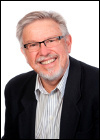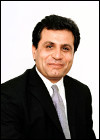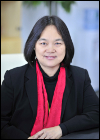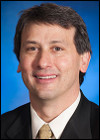KEYNOTE SPEAKERS
Wednesday, 11 June 2014, 9:30-10:30 - Opening Ceremony
Professor Bijan Jabbari, George Mason University:
Wireless Evolution: From Connecting People to Connecting Machines
Thursday, 12 June 2014, 11.00 - 12.30 - Infrastructure for the Digital Economy
Emeritus Laureate Professor Rod Tucker, University of Melbourne: Australia’s National Broadband Network: politics confronts technology
Professor Rahim Tafazolli, The University of Surrey: 5G New Infrastructure for Digital Economy and Connected Society
Friday, 13 June 2014, 11.00 - 12.30 - Defining the Wireless Future
Dr Chih-Lin I, China Mobile Research Institute (CMRI): Vision 2020: Perspectives of Mobile Operators (5G: Data Rate and More)
Professor Theodore (Ted) S. Rappaport, New York University: Millimeter Wave Wireless Communications: The Renaissance of Computing and Communications
 |
Professor Bijan Jabbari
George Mason University |
Wireless Evolution: From Connecting People to Connecting Machines
Download slides
Advances in wireless technology have made access from smart devices to cloud and multimedia content delivery services part of our daily lives. In the past decade, considerable progress has been made in ecosystems built upon mobile cellular and wireless Internet access technologies. While present wireless technologies have resulted in significant increase in demand for bandwidth, future applications -especially machine-to-m
Dachine - will result in massive data traffic. Although part of the solution to this challenge can be envisioned through cognitive radio networking technology, which will be discussed in this presentation, there remain other challenges to address the forthcoming innovative machine-to-machine applications and their sustained impact. In this talk, we review key recent innovations in wireless technology and discuss three main requirements that must be met to achieve a functional wireless ecosystem for our connected society including connected machines. We present the recent results of our research in this area to address these requirements.
Biography
Bijan Jabbari is a professor in the department of electrical and computer engineering at George Mason University in Fairfax, Virginia, USA. He is also an affiliated faculty member with Telecom Paris-Tech (ENST-Paris) in France. He received his MS and PhD degrees in electrical engineering from Stanford University, Stanford, California.
Prof. Jabbari’s area of specialization and interest is in wireless communication networks with particular emphasis on multi-user access, resource allocation, and performance optimization. He received the IEEE Fellow grade, the IEEE Millennium Medal and the Washington DC Metropolitan Area Engineer of the Year Award. He is a recipient of the Outstanding Faculty Research Award at the School of Engineering of George Mason University.
Prof. Jabbari served as the editor of Wireless Multiple Access for the IEEE Transactions on Communications, was an international division editor for Wireless Communications (Div. II) of the Journal of Communications and Networks, and was on the editorial board of the Proceedings of the IEEE, as well as serving in different editorship capacities for several other journals. He has been an advisor to the wireless communications industry, government, and the European Commission.
 |
Emeritus Laureate Professor Rod Tucker
Melbourne University |
Infrastructure for the Digital Economy - Australia’s National Broadband Network: politics confronts technology
Download slides
When first announced five years ago, Australia’s National Broadband Network (NBN) promised to connect fibre to 93% of Australian homes and businesses. But a new government, elected in 2013, is proposing to use lower-cost and lower-bandwidth copper-based connections in place of fibre. This talk will give an overview of the current status of the NBN project and provide a perspective on how the political and technology debates shaped the extraordinary story of Australia’s brief flirtation with a national high-speed fibre network.
Biography
Rod Tucker is an Emeritus Laureate Professor at the University of Melbourne and a Fellow of the IEEE. He has previously held positions at the Plessey Company, AT&T Bell Laboratories, Hewlett Packard Laboratories, and Agilent Technologies. He has served as a member of the Board of Governors of the IEEE Photonics Society and the Administrative Committee of the IEEE Microwave Theory and Techniques Society. He was Editor-in-Chief of the IEEE Transactions on Microwave Theory and Techniques from 1988 to1990, and Associate Editor of IEEE Photonics Technology Letters from 1997 – 2006. From 2008 to 2011 he was Vice-President, Publications of the IEEE Photonics Society. In 2009, he served on the Australian Federal Government’s Panel of Experts, which provided advice on the establishment of a National Broadband Network in Australia. Professor Tucker is a Board Member of GreenTouch, a global consortium focused on research and development in energy-efficient information and communications networks.
 |
Professor Rahim Tafazolli
The University of Surrey |
Infrastructure for the Digital Economy - 5G New Infrastructure for Digital Economy and Connected Society
The talk will present some economic and market drivers for start of research on 5G. It will present justifications that there is a need for a new approach to 5G which is fundamentally different from previous generations of mobile cellular systems. In achieving this vision, it will also propose a number of strategically important research and innovation areas for research community which are also pursued in the 5G Innovation Centre (5GIC) at the University of Surrey and their industrial members. It will also provide a list of requirements and targets that need to be set by standardization bodies and taken into consideration by national and international regulators.
Biography
Professor Tafazolli is the Director of the Centre for Communications Systems Research (CCSR) and 5G Innovation Centre (5GIC), The University of Surrey in the UK. He has published more than 500 research papers in refereed journals, international conferences and as invited speaker, and is the editor of two books on “Technologies for Wireless Future” published by Wiley’s Vol.1 in 2004 and Vol.2 2006. He is currently chairman of EU Net!Works Technology Platform Expert Group, board member of the UK Future Internet Strategy Group (UK-FISG). Professor Tafazolli was appointed as Fellow of WWRF (Wireless World Research Forum) in April 2011, in recognition of his personal contribution to the wireless world as well as heading one of Europe’s leading research groups.
 |
Dr Chih-Lin I
Chief Scientist of Wireless Technologies
China Mobile |
Defining the Wireless Future - Vision 2020: Perspectives of Mobile Operators (5G: Data Rate and More)
Download slides
With the issuing of TD-LTE licenses in mainland China, the world’s largest mobile market entered the 4G era before the end of 2013. Meanwhile, the whole world is trying to see through the veil blurring our view of the wireless society in year 2020, widely considered as the 5G Era. 5G has become the hottest key word in wireless industry since the last year.
One common consensus is that next generation of wireless system will face a 1000x traffic load increase. The first question is then how to increase network capacity dramatically while keeping the TCO at a reasonable level. Moreover, what user needs must be met by 5G? How will wireless technologies and mobile infrastructure be integrated then? Are there any particular needs from mobile operator’s point of view? How will mobile operators stay on the center stage in the future? What kind of technologies are they looking for? What’s the likely roadmap towards next generation mobile network? This talk will give an insight into these questions and share CMCC’s view as well as selected technology updates.
Biography
Chih-Lin I is the China Mobile Chief Scientist of Wireless Technologies, in charge of advanced wireless communication R&D effort of China Mobile Research Institute (CMRI). She established the Green Communications Research Center of China Mobile, spearheading major initiatives including 5G Key Technologies R&D; high energy efficiency system architecture, technologies, and devices; green energy; C-RAN and soft base station.
Chih-Lin received her Ph.D. degree in Electrical Engineering from Stanford University, has almost 30 years experience in wireless communication area. She has worked in various world-class companies and research institutes, including wireless communication fundamental research department of AT&T Bell Labs; Headquarter of AT&T, as Director of Wireless Communications Infrastructure and Access Technology; ITRI of Taiwan, as Director of Wireless Communication Technology; Hong Kong ASTRI, as VP and the Founding GD of Communications Technology Domain. Chih-Lin received the Trans. COM Stephen Rice Best Paper Award, and is a winner of CCCP “National 1000 talent” program. She was an elected Board Member of IEEE ComSoc, Chair of ComSoc Meeting and Conference Board, and the Founding Chair of IEEE WCNC Steering Committee. She is currently an Executive Board Member of GreenTouch, and a Network Operator Council Member of ETSI NFV.
 |
Professor Theodore (Ted) S. Rappaport
New York University |
Defining the Wireless Future - Millimeter Wave Wireless Communications: The Renaissance of Computing and Communications
Download slides
The wireless and internet industries are both about 30 years old and, during the past few decades, the average consumption of digital data per citizen on the planet has doubled every 40 months. Given recent expansions in optical backbones and local area connectivity investments throughout the world, spurred on by the overwhelming success of the Internet, mobile telephones, smartphones, and WiFi, the world is about to see a staggering increase in the growth and demand for data. Recently, millimeter wave and terahertz frequencies have been shown to offer capabilities never before imagined for high-speed wireless connectivity, both for mobile communications and fixed backhaul. This talk explores the remarkable expansion in capacity and services that future millimeter-wave communications will offer, and illustrates many technical problems that are within reach of being solved to enable completely new applications and solutions that will bring wireless communications into its Renaissance.
Biography
Theodore (Ted) S. Rappaport is the David Lee/Ernst Weber Professor of Electrical and Computer Engineering at the Polytechnic Institute of New York University (NYU-Poly) and is a professor of computer science at New York University’s Courant Institute of Mathematical Sciences. He is also a professor of radiology at the New York University School of Medicine.
Rappaport is the founder and director of NYU WIRELESS, one of the world’s first academic research centers to combine wireless engineering, computer science, and medicine. Earlier in his career, he founded two of the world’s largest academic wireless research centers: the Wireless Networking and Communications Group (WNCG) at the University of Texas at Austin in 2002, and the Mobile and Portable Radio Research Group (MPRG), now known as Wireless@Virginia Tech, in 1990. He has founded two companies, both sold to publicly traded firms, that have pioneered some of the technologies now used in the wireless industry.
Rappaport is a pioneer in the fields of radio wave propagation for cellular and personal communications, wireless communication system simulation, analysis and design, and broadband wireless communications circuits and systems at millimeter wave frequencies. His research has influenced many international wireless standard bodies over three decades, and he and his students have invented measurement equipment, simulation methodologies, and analytical approaches for the exploration and modeling of radio propagation channels and communication system design in a vast range of spectrum bands for emerging wireless systems. More recently, his work has explored the millimeter wave (mmWave) bands for future broadband access.
In 2006, Rappaport was elected to the Board of Governors of the IEEE Communications Society (ComSoc), and to the Board of Governors of the IEEE Vehicular Technology Society (VTS) in 2008 and again in 2011. He is a fellow of the IEEE, is a member of the board of the Marconi Society, and serves on the editorial boards of several academic and technical journals. He received the Marconi Young Scientist Award in 1990, an NSF Presidential Faculty Fellowship in 1992, the Sarnoff Citation from the Radio Club of America in 2000, the Fredrick E. Terman Outstanding Electrical Engineering Faculty Award from the American Society for Engineering Education in 2002, the Stuart F. Meyer Award from the IEEE Vehicular Technology Society in 2005, the Sir Monty Finniston Medal from the IET in 2011, and the William E. Sayle achievement award from the IEEE Education Society in 2012.
Rappaport has over 100 U.S. or international patents issued or pending and has authored, co-authored, and co-edited over 200 papers and 20 books in the wireless field, including Wireless Communications: Principles & Practice (translated into seven languages), Principles of Communication Systems Simulation with Wireless Applications, and Smart Antennas for Wireless Communications: IS-95 and Third Generation CDMA Applications. His latest book, Millimeter Wave Wireless Communications, will be released in spring 2014.
Rappaport received BS, MS, and PhD degrees in electrical engineering from Purdue University in 1982, 1984, and 1987, respectively, and is a Distinguished Engineering Alumnus of his alma mater.
Back home >>






